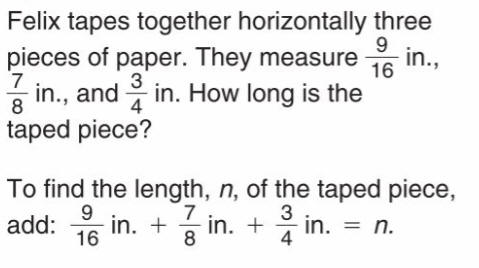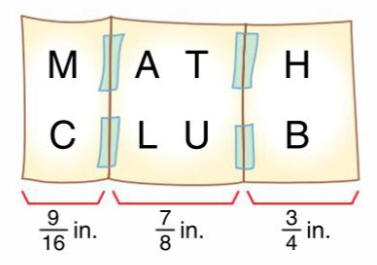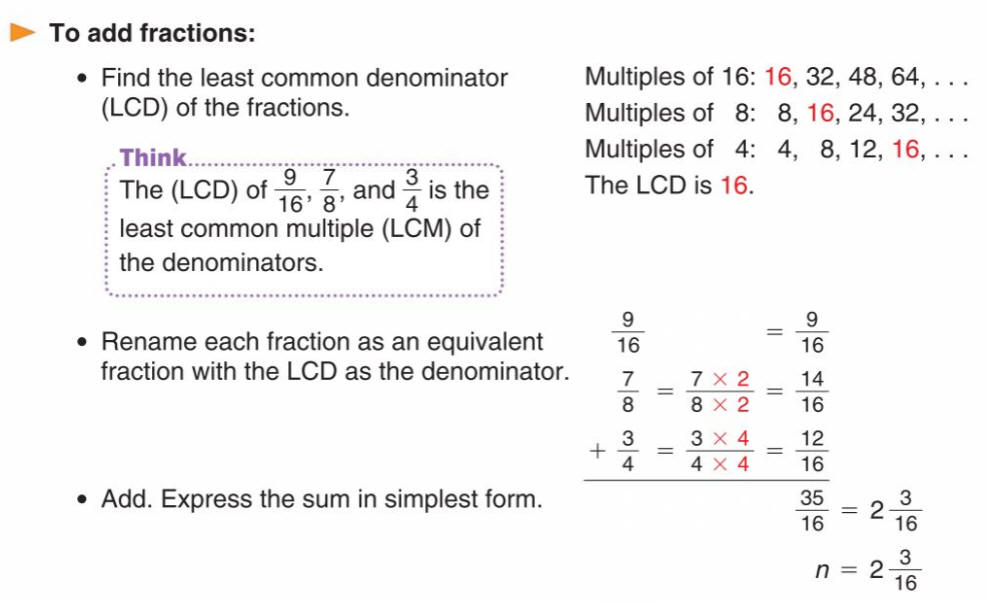%20for%20web.gif)
Our Lady Help of Christians Academy
%20for%20web.gif)
(Back to 6th Grade Home) (6th Math Archive)
6th Grade Math
__________________________________________________
6th Math Assignments for May 11th - 15th
These assignments are due Monday, May 18th. Paper copies were sent home with the pick-up packets. Digital copies are provided below, for viewing or downloading/printing.
This week we'll use Greatest Common Factors and Least Common Multiples to help us add and subtract proper and improper fractions and mixed numbers.
Explanations of each concept can be found in the lesson summaries below, and in the math textbook.
Adding Fractions (Chapter 7-3)
-Adding Mixed Numbers (Chapter 7-4)
-Subtracting Fractions (Chapter 7-5)
-Subtracting Mixed Numbers (Chapter 7-6)
Adding Fractions (Chapter 7-3)
Look at this example:


Remember, before we can start adding, we need to have a common denominator!

So Felix's sign is 2 3/16" long.
Adding Mixed Numbers (Chapter 7-4)
Look at this example:
Notice that in this example, the denominators are already the same!
Now look at another example, where the denominators are NOT already the same - we have to start by finding the LCD (lowest common denominator).
How do we find the LCD? We look at all of the denominators, and we find their LCM. That LCM will be our common denominator, our "LCD."
Sometimes we will add a whole number to a mixed number. No problem, just add the whole numbers together and be sure to include the fraction in your answer (the first example, below).
Sometimes we'll get an answer where the fraction part is an improper fraction (that is, it's more than a whole). When that happens, we need to change that improper fraction into a mixed number and add again. That gives us a final answer that's in the proper form.
Subtracting Fractions (Chapter 7-5)
Remember that we have to find a common denominator when we subtract fractions, too. Look at this example.
Subtracting Mixed Numbers (Chapter 7-6)
Look at this example:
Notice that in this example, the denominators are already the same!
Now look at another example, where the denominators are NOT already the same - we have to start by finding the LCD (lowest common denominator).
How do we find the LCD? We look at all of the denominators, and we find their LCM. That LCM will be our common denominator, our "LCD."
Sometimes when we subtract fractions, the numerator of the smaller fraction may be larger than the numerator of the larger fraction.
See the example below.
Here, our problem has us subtracting 3/4 from 1/4 - how do we do that?!
Well, we take a whole from 6 - since we have 4ths in this problem, we'll take 4/4 as our whole - and add it to the fraction part.
So our 6 becomes 5 (since we took 4/4 out of the 6), and our fraction part becomes 5/4 instead of 1/4 (since we added that 4/4 to the 1/4).
Now we can easily subtract 3/4 from 5/4, no problem!
__________________________________________________
Please continue to study your math facts (multiplication, division, addition, subtraction).
If you happen to find a nice online flashcard app or site, please send me an email!